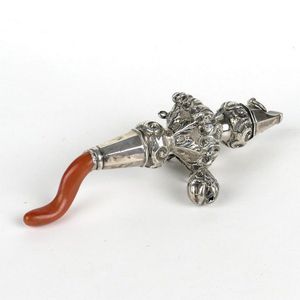Sterling Silver Marcasite Lizard and Accessories
You must be a subscriber, and be logged in to view price and dealer details.
Subscribe Now to view actual auction price for this item
When you subscribe, you have the option of setting the currency in which to display prices to $Au, $US, $NZ or Stg.
- Sterling Silver - Sterling silver is a mixture of 92.5% pure silver and 7.5% of another metal, usually copper. Fine silver is 99.9% pure silver, and is relatively soft and the addition of the very small amount of copper gives the metal enough strength and hardness to be worked into jewellery, decorative and household objects.
- Onyx - Onyx is a form of agate, used from antiquity and popular again in the 1920s and 30s. European onyx is generally green, but can be many other colours, and can contain bands of black and/or white.
This multicoloured stone is widely used for table tops, lamp bases and in jewellery. Some types of onyx are also used for cameos of which the upper white layer is cut away to reveal the colour beneath. - Marcasite - Marcasite is a mineral, iron sulphide, but is rarely used in jewellery. Instead marcasite is the name given to iron pyrites, the mineral sold as marcasite which is identical in copmosition to iron sulphide but crystalises as a cube, making it more suitable for jewellery. It is a brassy yellow in colour and is also known as "fool's gold", and sits well with silver rather than gold becasue of its colour.
Marcasite has been used in jewellery since ancient times and became popular again in jewellery in the 18th century, continuing through to the early 20th century, with the settings becoming cheaper as time progressed, eventually earning the sobriquet "costume jewellery" along with other cheap jewellery that was made for a prevailing pattern and meant to be changed with each new outfit. - Art Deco Period - The Art Deco period was a cultural movement that emerged in the 1920s and 1930s, and was characterized by its emphasis on modernism, luxury, and elegance. The name "Art Deco" comes from the Exposition Internationale des Arts Décoratifs et Industriels Modernes, a large exhibition held in Paris in 1925 that showcased the latest trends in decorative arts.
Art Deco was a reaction against the ornate and elaborate styles of the previous era, and reflected a new modern sensibility. It was characterized by streamlined, geometric shapes, bright colours, and the use of new materials such as chrome, glass, and Bakelite. Art Deco designers sought to create a sense of luxury and sophistication, often incorporating expensive materials such as ivory, marble, and rare woods.
Art Deco had a significant impact on a wide range of artistic fields, including architecture, fashion, graphic design, and interior design. Some of the most iconic examples of Art Deco architecture include the Empire State Building in New York City, the Hoover Building in London, and the Palais de Chaillot in Paris.
The Art Deco period came to an end in the 1940s, as World War II and changing cultural trends led to a shift in artistic styles. However, Art Deco remains an important influence on design and art, and continues to be celebrated for its modernist sensibility and glamorous aesthetic.
This item has been included into following indexes:
Visually similar items

An Australian 9ct yellow gold amethyst fluted bar brooch one round amethyst, made by T. Willis & Co, Melbourne

A Victorian silver and coral baby's rattle, the elaborately embossed rattle with one bell, whistle and coral to the end. Date marks absent, maker I.H. Length 11 cm

A diamond set vintage brooch. Platinum, crafted as two waved bars of grain set small old cut diamonds, terminating at each end with a single larger claw set diamond, centrally dropping to a triple cluster of three larger old cut diamonds, claw set, totalli

Platinum, blue topaz and diamond brooch, mid 20th century, the stylised ribbon and foliate spray set to the centre with a circular-cut blue topaz accented with old mine and circular-cut diamonds, length approximately 65 mm.
